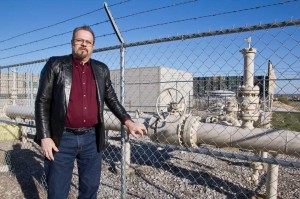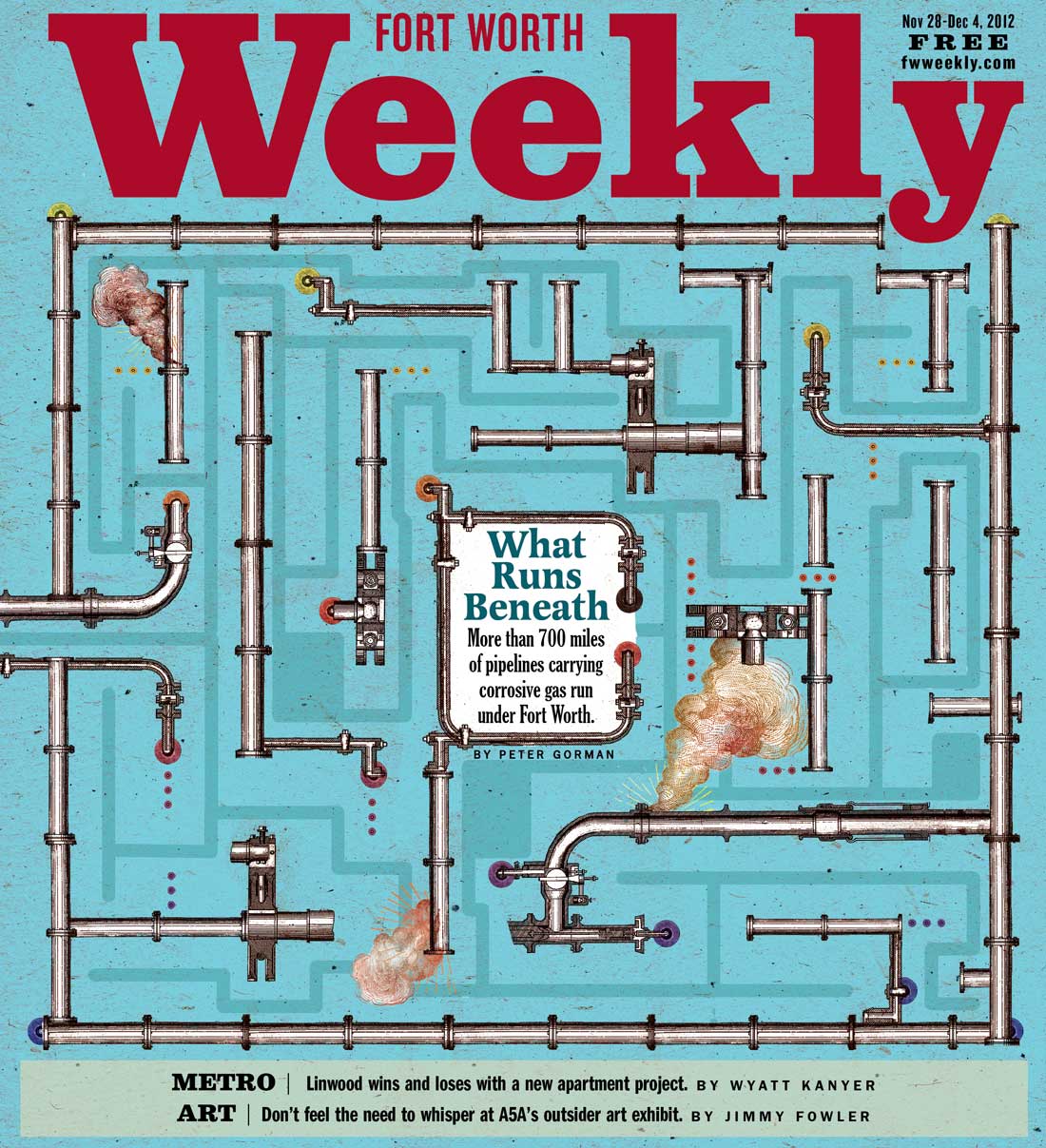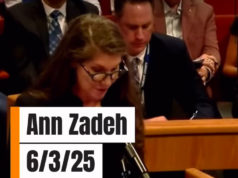On Monday, June 7, 2010, workers installing a utility pole outside of Cleburne, in Johnson County, struck a buried natural gas line. The explosion that followed left one person dead, sent several others to area hospitals, and shot a fireball into the sky that could be seen in Fort Worth. Two hours later, the fire continued to burn while pipeline workers worked to reach the cut-off valve to the ruptured line.
A subsequent investigation showed that the utility workers had done everything right: They’d called 811 and other services to find out the location of pipelines in the area and didn’t start digging until they got the all-clear. Problem was, the pipeline they hit was nowhere near where it was supposed to be.
In 2008, more than two years before the Cleburne tragedy, the Fort Worth Gas Drilling Task Force called for the mapping of all Barnett Shale pipelines running underneath the city. Pipeline companies were required to provide “as-built” drawing of the pipelines with digital files that tied the lines to precise geographic markers and gave locations of cut-off valves.
The city planned to take that information and make a digital map showing the exact location of every new gas pipeline in the city. The map would be available to first responders and hazardous-material teams in the event of a leak or gas line explosion.
But for three years, Fort Worth, which has earned millions from gas revenues, ironically was unable to come up with the $150,000 or so needed to produce such a map system.
Finally, in July 2011, the city chose the civil engineering firm Pacheco Koch to design the system. And now the city has hired a mapper who will input and update the pipeline information that’s been collected.
According to Rick Trice, assistant director for the city’s gas drilling and leasing division, that work will start in the next few weeks, and if all goes well the 150 miles or so of gas lines laid in Fort Worth since Jan. 1, 2009, will be mapped within a year. The locations will be accurate to within centimeters, he said.
But gas drilling in the area didn’t start in 2009. So the map that’s being produced now won’t include another 500 to 600 miles of gas pipeline laid prior to and during the first few years of the Barnett Shale boom. And there are no plans to map all those other pipelines.
“Going back several years, it gets difficult. It’s like a maze, really, with pipeline companies having changed hands over the years, and some of that information would probably be difficult to get,” Trice said. Information on pre-2009 pipelines is available on the Texas Railroad Commission’s website, but it’s not GPS (global positioning system) accurate, Trice said. The explosion in Cleburne was a tragic result of such inaccuracy.
The city could have had information on older pipelines as early as 2009, according to Gary Hogan, who served on both of the city’s gas drilling task forces. Hogan said he remembers the drilling companies offering to provide the locations.
What difference would accurate mapping make? It could prevent construction crews from hitting pipelines and causing explosions and, theoretically, allow regulators to do their jobs better.
Gathering lines are the least regulated type of line in the whole pipeline system. Because they carry “wet,” mostly unodorized gas, they are the most likely to corrode. Because of the way gathering lines are built, they are much more likely to explode than to leak — and leaks are dangerously difficult to detect.
In Fort Worth, where you’re never more than about a mile from a gas well, you’re probably never more than a half-mile from a gas pipeline.

“Everyone in the industry thinks this is a ticking time bomb,” said a former pipeline executive who asked that his name not be used. “The truth is, it’s just insane to have wet gas around schools. Yet you go down to Vickery and Horne and turn north and see pipes right across the street from a school. And all pipes leak over time. They corrode and rot out, and the initial builder sells out, and you wind up with some jackleg [company] with little insurance owning the lines, not being able to maintain them properly.”
The lack of regulation by the state and local governments is “simply gross negligence,” he said.
Whatever the regulatory situation, emergency responders have to deal with the aftermath. Accurate maps showing which direction gas is flowing in a pipeline can help in the event of a leak that forces a neighborhood evacuation.
And yet Juan Ortiz, emergency management coordinator for Fort Worth and Tarrant County, said pipeline maps won’t help minimize harm in the event of an explosion or leak and wouldn’t affect emergency response, even if every line were accurately depicted.
“Even if we have exact pipeline locations, we’d have to locate the exact spot of the leak. And that’s not easy,” he said. “And then, even if that map includes shut-off valves, we’re not authorized to shut lines down. We’re not trained for that. That requires someone with the pipeline outfit, so even in an emergency you need to wait until they come and shut that line down.
“The whole issue is a challenging task,” Ortiz said.
Hogan thinks the city’s effort is too little, too late.
Jerry Lobdill, retired physicist and longtime opponent of urban gas drilling, thinks that the city’s map project will be nowhere near as accurate as Trice described. He predicted that first responders would not have the know-how to deal with a catastrophic pipe failure.
Royce Don Deaver of Houston, a pipeline engineer and expert witness in pipeline explosion cases, said that the older lines are more dangerous because of the corrosive nature of wet gas. He sees the mapping of only newer lines as a recipe for disaster.
That’s quite a mix of sentiment on an issue that can turn a neighborhood into a fireball in a matter of seconds.
********













Great article.
I can only imagine the potential disasters awaiting the poor working guys who have to do the dirty, dangerous job of construction digging when Fort Worth’s pipeline documentation is so miserably bad.
Meanwhile, the demagogues who run Fort Worth continue to function as ‘two dollar whores’ for any and all business ventures, especially energy industry business, that wave money under a Cowtown politician’s nose.
About the pipeline explosion in Cleburne:
TRRC Williams stated they receive 1. 8,000,000 dig request per year and only 1 percent results in a nick of the pipeline. That is 18,000!
http://www.wfaa.com/news/local/Oil-well-explodes-in-Hood-County-95801134.html
About the pipeline explosion in Cleburne:
TRRC Williams stated they receive 1. 8,000,000 dig request per year and only 1 percent results in a nick of the pipeline. That is 18,000!
www@wfaa@com/news/local/Oil-well-explodes-in-Hood-County-95801134.html
About the pipeline explosion in Cleburne:
TRRC Williams stated they receive 1. 8,000,000 dig request per year and only 1 percent results in a nick of the pipeline. That is 18,000!
www@wfaa@com/news/local/Oil-well-explodes-in-Hood-County-95801134@html
About the pipeline explosion in Cleburne:
TRRC Williams stated they receive 1. 8,000,000 dig request per year and only 1 percent results in a nick of the pipeline. That is 18,000!
www@wfaa@com/
news/local/
Oil-well-explodes-in-Hood-County-95801134@html
About the pipeline explosion in Cleburne:
TRRC Williams stated they receive 1. 8,000,000 dig request per year and only 1 percent results in a nick of the pipeline. That is 18,000!
Your mobile app is buggy,sorry about dup post